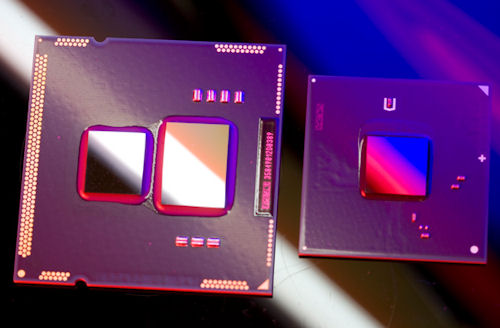Fusion first
Combining CPU and GPU on to one package - LGA1156So 32nm Westmere is just 45nm Nehalem with a die-shrink, core-shrink, and hardware-based AES thrown in for good measure? Weighing in at around 185m transistors for the dual-core chip, compared to quad-core Nehalem's 731m, and helped further by having a smaller manufacturing process, there's a lot of spare room on chip's package.
Intel is using this spare room to move the integrated graphics processor (IGP) from the northbridge on a traditional motherboard chipset to the CPU's package itself. This means that the computational processing and display portions of a PC can be run from a single 'package'. A distinction is required between package and chip, because the graphics portion of the processor is based on separate silicon.
This Intel-provided shot shows the desktop Westmere processor, Clarkdale, on the left package. The right-hand package is home to the associated chipset.
The two 'blobs' of silicon represent the 32nm CPU (left) and GPU (right). They're connected to one another by a QPI link operating at 6.4GT/s, as found on first-generation Nehalem chips. The reason that the two portions are not melded together on to one monolithic die lies with a) the complexity of doing so and b) the fact that the GPU part is manufactured on a 45nm process. Intel's already achieved 'proper' fusion with the new Atom chip.
Why not together?
The memory-controller portion of the IGP has been moved on to the GPU side, most likely due to the fact that the port from present 45nm production - as per the case of Lynnfield and Bloomfield - would be easier than shrinking it down to 32nm. There may also be a few performance-related issues regarding the integrated graphics' data jumping back and forth over the QPI link, too.
Intel's previous top-of-the-line integrated graphics, known as X4500 HD and found on the G4-series chipsets, is a rather anaemic 3D performer and contains an average 2D feature-set. AMD's northbridge-based IGPs have had the better of Intel's for a while now, and the latest iteration, Radeon HD 4200, supports DX10.1 gaming and beats out the X4500 HD for low-quality gaming and, well, everything else. The new Intel-integrated graphics promise more performance than X4500 HD in every aspect, and we'll be taking a detailed look later.










